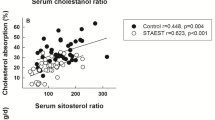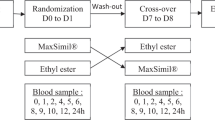Abstract
Purpose
Consumption of phytosterols is a nutritional strategy to reduce cholesterol absorption, but the efficacy of various phytosterol intake modalities remains uncertain. The main objective was to investigate the effects of phytosterol esters (PE) provided either as a spread (dispersed in fat) during a mixed meal or as a minidrink (micro-dispersed in liquid form) after a meal.
Methods
In a randomized, single-blinded crossover design, 12 healthy intubated volunteers tested three different liquid meal sequences with and without PE. The liquid meal (500 mL, Fortisip) contained an oral dose (80 mg) of deuterium-enriched cholesterol (D7C). The intubation was stopped at 240 min, and the fate of sterols was determined in the different phases of duodenal content samples as function of time. A second solid fat-containing meal without sterols was consumed at 270 min. D7C was quantified in chylomicrons and plasma for 8 h. The conditions tested were as follows: (1) no PE added (control), (2) PE in a spread added into a liquid meal (PE-spread meal) and (3) PE given 30 min after a liquid meal as 100-g yoghurt drink (PE-minidrink meal).
Results
Addition of PE decreased the incorporation of cholesterol into the duodenum aqueous phase including micelles. PE added as a spread or as a minidrink significantly and comparably lowered meal cholesterol occurrence in chylomicrons (−40 % for PE-spread and −54 % for PE-minidrink, p < 0.0001) compared with the control meal.
Conclusions
PE either dispersed in fat during a meal or micro-dispersed in a liquid form after a meal resulted in a markedly reduced occurrence of meal-derived cholesterol in the circulation at a comparable extent.



Similar content being viewed by others
Abbreviations
- PE:
-
Phytosterol esters
- CE:
-
Cholesterol esters
- P:
-
Phytosterol
- C:
-
Cholesterol
- D7C:
-
Deuterium-enriched cholesterol
References
Ostlund RE Jr (2002) Phytosterols in human nutrition. Annu Rev Nutr 22:533–549
Tapiero H, Townsend DM, Tew KD (2003) Phytosterols in the prevention of human pathologies. Biomed Pharmacother 57:321–325
Jones PJ, AbuMweis SS (2009) Phytosterols as functional food ingredients: linkages to cardiovascular disease and cancer. Curr Opin Clin Nutr Metab Care 12:147–151
Racette SB, Lin X, Lefevre M, Spearie CA, Most MM, Ma L, Ostlund RE Jr (2010) Dose effects of dietary phytosterols on cholesterol metabolism: a controlled feeding study. Am J Clin Nutr 91:32–38
EFSA So (2009) Plant stanols and plant sterols and blood LDL-cholesterol. Scientific opinion of the panel on dietetic products nutrition and allergies on a request from the European Commission and a similar request from France in relation to the authorization procedure for health claims on plant stanols and plant sterols and lowering/reducing blood LDL-cholesterol pursuant to Article 14 of Regulation (EC) No 1924/20061. EFSA J 1175:1–9
Amiot MJ, Knol D, Cardinault N, Nowicki M, Bott R, Antona C, Borel P, Bernard JP, Duchateau G, Lairon D (2011) Phytosterol ester processing in the small intestine: impact on cholesterol availability for absorption and chylomicron cholesterol incorporation in healthy humans. J Lipid Res 52:1256–1264
Law M (2000) Plant sterol and stanol margarines and health. BMJ 320:861–864
Lee YM, Haastert B, Scherbaum W, Hauner H (2003) A phytosterol-enriched spread improves the lipid profile of subjects with type 2 diabetes mellitus—a randomized controlled trial under free-living conditions. Eur J Nutr 42:111–117
Volpe R, Niittynen L, Korpela R, Sirtori C, Bucci A, Fraone N, Pazzucconi F (2001) Effects of yoghurt enriched with plant sterols on serum lipids in patients with moderate hypercholesterolaemia. Br J Nutr 86:233–239
Mensink RP, Ebbing S, Lindhout M, Plat J, van Heugten MM (2002) Effects of plant stanol esters supplied in low-fat yoghurt on serum lipids and lipoproteins, non-cholesterol sterols and fat soluble antioxidant concentrations. Atherosclerosis 160:205–213
Spilburg CA, Goldberg AC, McGill JB, Stenson WF, Racette SB, Bateman J, McPherson TB, Ostlund RE Jr (2003) Fat-free foods supplemented with soy stanol–lecithin powder reduce cholesterol absorption and LDL cholesterol. J Am Diet Assoc 103:577–581
Demonty I, Ras RT, van der Knaap HC, Duchateau GS, Meijer L, Zock PL, Geleijnse JM, Trautwein EA (2009) Continuous dose-response relationship of the LDL-cholesterol-lowering effect of phytosterol intake. J Nutr 139:271–284
Beaumier-Gallon G, Dubois C, Senft M, Vergnes MF, Pauli AM, Portugal H, Lairon D (2001) Dietary cholesterol is secreted in intestinally derived chylomicrons during several subsequent postprandial phases in healthy humans. Am J Clin Nutr 73:870–877
Armand M, Borel P, Dubois C, Senft M, Peyrot J, Salducci J, Lafont H, Lairon D (1994) Characterization of emulsions and lipolysis of dietary lipids in the human stomach. Am J Physiol 266:G372–G381
Armand M, Borel P, Pasquier B, Dubois C, Senft M, Andre M, Peyrot J, Salducci J, Lairon D (1996) Physicochemical characteristics of emulsions during fat digestion in human stomach and duodenum. Am J Physiol 271:G172–G183
Armand M, Pasquier B, Andre M, Borel P, Senft M, Peyrot J, Salducci J, Portugal H, Jaussan V, Lairon D (1999) Digestion and absorption of 2 fat emulsions with different droplet sizes in the human digestive tract. Am J Clin Nutr 70:1096–1106
Dubois C, Beaumier G, Juhel C, Armand M, Portugal H, Pauli AM, Borel P, Latge C, Lairon D (1998) Effects of graded amounts (0–50 g) of dietary fat on postprandial lipemia and lipoproteins in normolipidemic adults. Am J Clin Nutr 67:31–38
Hofmann AF, Borgstroem B (1964) The intraluminal phase of fat digestion in man: the lipid content of the micellar and oil phases of intestinal content obtained during fat digestion and absorption. J Clin Invest 43:247–257
Hernell O, Staggers JE, Carey MC (1990) Physical-chemical behavior of dietary and biliary lipids during intestinal digestion and absorption. 2. Phase analysis and aggregation states of luminal lipids during duodenal fat digestion in healthy adult human beings. Biochemistry 29:2041–2056
Beaumier-Gallon G, Dubois C, Portugal H, Lairon D (1998) Postprandial studies on dietary cholesterol in human subjects using stable isotopes and gas chromatography–mass spectrometry analysis. Atherosclerosis 141(Suppl 1):S81–S85
Beaumier-Gallon G, Lanfranchi J, Vergnes MF, Lairon D, Pastor J, Pauli AM, Portugal H (1998) Method for simultaneous measurements of traces of hepta deuterated cholesterol and cholesterol by gas chromatography-mass spectrometry: application in humans. J Chromatogr B Biomed Sci Appl 718:23–32
Brown AW, Hang J, Dussault PH, Carr TP (2010) Phytosterol ester constituents affect micellar cholesterol solubility in model bile. Lipids 45:855–862
Nissinen M, Gylling H, Vuoristo M, Miettinen TA (2002) Micellar distribution of cholesterol and phytosterols after duodenal plant stanol ester infusion. Am J Physiol Gastrointest Liver Physiol 282:G1009–G1015
Nissinen MJ, Vuoristo M, Gylling H, Miettinen TA (2007) Respective hydrolysis and esterification of esterified and free plant stanols occur rapidly in human intestine after their duodenal infusion in triacyl- or diacylglycerol. Lipids 42:603–612
Normen L, Ellegard L, Janssen HG, Steenbergen H, Trautwein E, Andersson H (2006) Phytosterol and phytostanol esters are effectively hydrolysed in the gut and do not affect fat digestion in ileostomy subjects. Eur J Nutr 45:165–170
Ikeda I, Tanabe Y, Sugano M (1989) Effects of sitosterol and sitostanol on micellar solubility of cholesterol. J Nutr Sci Vitaminol (Tokyo) 35:361–369
Mel’nikov SM, Seijen ten Hoorn JW, Eijkelenboom AP (2004) Effect of phytosterols and phytostanols on the solubilization of cholesterol by dietary mixed micelles: an in vitro study. Chem Phys Lipids 127:121–141
Haikal Z, Play B, Landrier JF, Giraud A, Ghiringhelli O, Lairon D, Jourdheuil-Rahmani D (2008) NPC1L1 and SR-BI are involved in intestinal cholesterol absorption from small-size lipid donors. Lipids 43:401–408
Ostlund RE Jr, Spilburg CA, Stenson WF (1999) Sitostanol administered in lecithin micelles potently reduces cholesterol absorption in humans. Am J Clin Nutr 70:826–831
Normen L, Dutta P, Lia A, Andersson H (2000) Soy sterol esters and beta-sitostanol ester as inhibitors of cholesterol absorption in human small bowel. Am J Clin Nutr 71:908–913
Miettinen TA, Vuoristo M, Nissinen M, Jarvinen HJ, Gylling H (2000) Serum, biliary, and fecal cholesterol and plant sterols in colectomized patients before and during consumption of stanol ester margarine. Am J Clin Nutr 71:1095–1102
Acknowledgments
We are grateful to Dr. Sophie Morange and the staff at the Clinical Investigation Centre, France, for clinical study assistance and to Dr. Matthieu Maillot for statistical analyses.
Conflict of interest
None of the authors had a personal or financial conflict of interest.
Author information
Authors and Affiliations
Corresponding author
Rights and permissions
About this article
Cite this article
Amiot, M.J., Knol, D., Cardinault, N. et al. Comparable reduction in cholesterol absorption after two different ways of phytosterol administration in humans. Eur J Nutr 52, 1215–1222 (2013). https://doi.org/10.1007/s00394-012-0432-3
Received:
Accepted:
Published:
Issue Date:
DOI: https://doi.org/10.1007/s00394-012-0432-3




